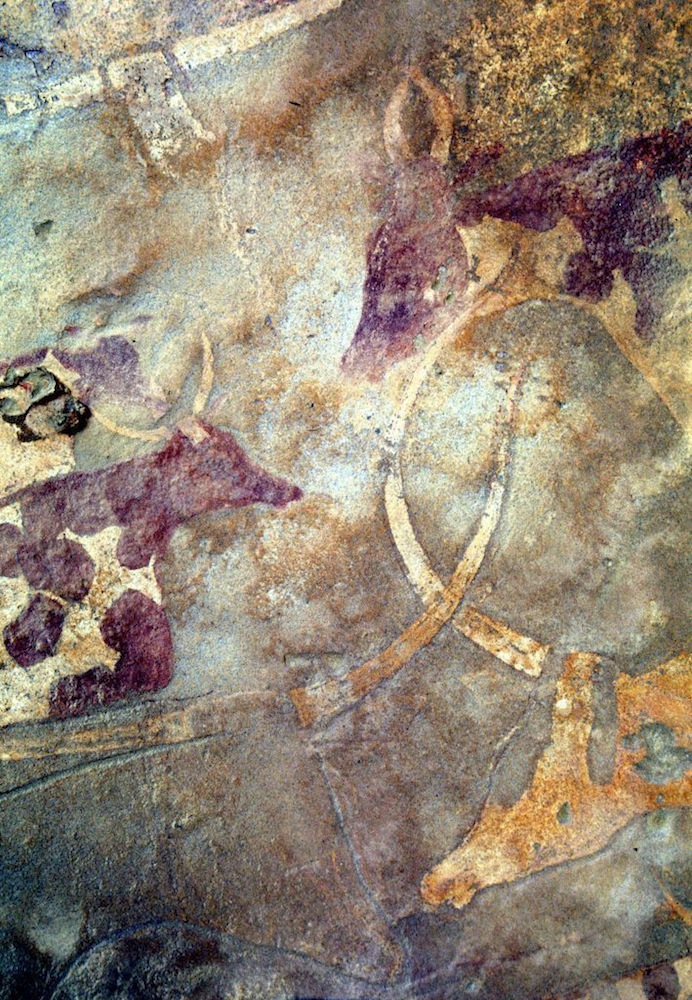Evidence of Use of Milk in Saharan Rock Art
One time-Green Sahara Hosted Early African Dairy Farms

The sandy dunes of the Sahara may seem an unlikely place for a dairy farm, but about vii,000 years agone, herders tended and milked cattle in what is now desolate desert, new inquiry shows.
Nigh 10,000 years agone, the Sahara desert went through a stage called the Holocene African Boiling Period. Fossilized bones bear witness that by the sixth millennium B.C. (or about vii,000 years ago), cattle, sheep and goats roamed over green savanna, and rock fine art depicts cows with full udders. The occasional paradigm even shows milking, said report researcher Julie Dunne, a doctoral student at the University of Bristol. Just it's difficult to get a house date for those images.
By analyzing pottery fragments, Dunne and her colleagues accept now shown that these early herders were not only milking their livestock, simply besides processing that milk into products like yogurt, cheese and butter.
"The virtually heady thing about this is that milk is 1 of the simply foodstuffs that gives us carbohydrates, protein and fat," all in i substance, Dunne told LiveScience. "And then it was incredibly beneficial for prehistoric people to use milk." [Top 10 Mysteries of the Starting time Humans]
Saharan dairies
Dunne and her colleagues analyzed tiny fragments of pottery taken from the Takarkori stone shelter, a prehistoric dwelling in the Libyan Sahara. They ground up small pieces of the pottery, conducting chemical analyses to investigate the proteins and fats embedded in the shards. By doing so, the researchers could see what the pots in one case held.

They found evidence of a varied nutrition, with signs plant for plant oils and brute fatty. The almost common fats were of brute origin, Dunne said, with some deriving from flesh and others from milk. The most dairy-fat rich pottery shards came from the same time periods when more cattle bones are found in the cave layers, the researchers reported today (June 20) in the journal Nature.
Past looking at variations in the carbon molecules in these preserved fats, the researchers were able to get an idea of what kind of plants the cattle were eating. They establish their diets varied betwixt then-called C3, or woody plants, and C4 plants, which include grasses grains and dry-weather plants. (C3 and C4 refer to the blazon of photosynthesis these plants use.)
That fits with the archaeological understanding of this early herding civilization as moving between seasonal camps, Dunne said. [Anthology: Faces of a Threatened Tribe]
"It suggests that they were moving between summertime and winter camps and eating different plants at one place than another, so this all ties together very nicely," she said.
Spread of milk and butter
No 1 has e'er earlier looked for bear witness of dairy farming in these herding tribes, Dunne said, but the new findings assistance explain how humans got their taste for milk. People first settled downwardly to an agricultural lifestyle in the Nearly East near 8,000 or 9,000 years ago, she said. Soon later on, they took upwardly dairy farming. The milk addiction then spread across Europe in fits and starts.
At the same time, though, people were also migrating from the Nigh East into what is now Arab republic of egypt and other parts of Africa, Dunne said. This movement spread dairying to north Africans, who were previously settled hunter-gatherers and fishermen. As new immigrants moved in with cattle, these native people would have quickly seen the benefits of "marvelous large hunks of food on the hoof," Dunne said.
Humans had to evolve to match their new source of protein, however. Originally, mankind was lactose intolerant, meaning that milk drinking was an invitation for an upset tum. Processing milk into yogurt and cheese would have helped, Dunne said, but humans also adapted: As dairying spread, and then did genes that confer lactose tolerance.
"You're actually seeing evolution in activeness over a very short timescale, just 1,000 to 2,000 years," Dunne said.
The researchers now plan to clarify more pottery samples from more than northern African dwellings. The goal, Dunne said, is to get a better picture show of how dairy — and cows — spread among the people of the continent.
Cattle "actually played an enormous function in their ideology and their general day-to-twenty-four hours life," she said.
Follow Stephanie Pappas on Twitter @sipappas or LiveScience @livescience . We're also on Facebook & Google+ .
Source: https://www.livescience.com/21070-green-sahara-hosted-african-dairy-farms.html

0 Response to "Evidence of Use of Milk in Saharan Rock Art"
Postar um comentário